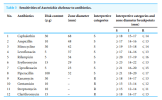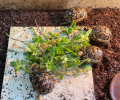- Joined
- Sep 23, 2012
- Messages
- 716
OK guys. During the past year I have observed/treated tortoises with Austwickia and documented the results. I have also discussed this disease with several veterinarians at this point and it's time for a data dump.
General information on the disease:
1. The "yellow bump" disease is caused by the bacterium Austwickia chelonae. It was renamed from Dermatophilus, and most vets are only familiar with this older name in the context of a closely related bacterium that affects mammals. The first symptom of infection is lack of growth, followed by yellow skin lesions. In bad cases, toenails and jaw sheaths become necrotic and fall off. Once symptomatic it is near 100% fatal without treatment.
2. It can be killed with ammonia-based disinfectants (we already knew this much). However it is quite difficult to fully eradicate, it will probably live in soils for quite some time (or indefinitely?) and thus creates the potential to hide somewhere and become infectious later. It is suspected that tortoises can be asymptomatic carriers, and visible cases in adult tortoises seem to be very rare.
3. It is everywhere. Large breeders, retailers, etc. across the country. A wild gopher tortoise in Florida. Wild crocodile lizards in China. We are past the point of being able to contain this, and so all captive bred hatchlings should be considered at risk of becoming sick, no matter where you obtain them. Once they are older (a year?) the risk is probably much less.
4. It is probably an opportunistic pathogen. From what we know, it wants wet conditions near 80F. It can survive in other conditions but may not grow or be infectious (we are not entirely sure). It is probable that exposed hatchlings will develop the disease, or not, depending on environment and possibly the strength of their immune system. I do fear a catch-22 that better husbandry may inadvertently increase risk given that the disease prefers high humidity. It seems probable that all species are susceptible, but this is not confirmed. I have not seen evidence of a case in star tortoises yet, for example.
5. I have some suspicion that it transmits vertically (mother to babies) via contamination of eggshells, but there is no hard evidence at this time.
Treatment:
1. If the tortoise is acting and eating normally, and has only skin lesions, there is a good chance it can be saved. A sensitivity study (below) performed by researchers in China confirmed that Austwickia is susceptible to antibiotics. The most useful finding is that penicillin-group antibiotics are effective. Ampicillin was used in the study, but would require regular injections for a long period of time (not a great idea for hatchling tortoises). I used amoxicillin (which is better absorbed when given orally than other penicillin antibiotics). My procedure was 100 mg/kg amoxicillin per day given orally. Tablets can be crushed, mixed with calcium supplement powder, and the appropriate dose can be dusted onto food each day. The disease is also susceptible to minocycline (and therefore likely tetracycline). I mention this because tetracycline is easy to find and may have been key to saving shawnateerow's sulcatas.

Reference: Jiang, H. et al. Identification of Austwickia chelonae as cause of cutaneous granuloma in endangered crocodile lizards using metataxonomics. PeerJ 2019 7:e6574
2. Treatment may require 3-4 months of antibiotics. I did not stop until all the skin bumps shed off and they started growing. During treatment the tortoise habitat should be made less hospitable for the pathogen. Complete disposal of existing substrate and swap to something that will not retain moisture. Dry conditions are not great for baby tortoises, but they can be kept hydrated by soaking / drinking. Do not worry about pyramiding at this time, it will only affect growing tortoises and they will not grow until they recover from the disease.
3. It might be useful to have a big temperature swing (day to night) if the tortoise species can tolerate it. This is purely speculative but if the bacteria prefer temperatures near 80F, we can deny them that satisfaction for at least some portion of the day.
General information on the disease:
1. The "yellow bump" disease is caused by the bacterium Austwickia chelonae. It was renamed from Dermatophilus, and most vets are only familiar with this older name in the context of a closely related bacterium that affects mammals. The first symptom of infection is lack of growth, followed by yellow skin lesions. In bad cases, toenails and jaw sheaths become necrotic and fall off. Once symptomatic it is near 100% fatal without treatment.
2. It can be killed with ammonia-based disinfectants (we already knew this much). However it is quite difficult to fully eradicate, it will probably live in soils for quite some time (or indefinitely?) and thus creates the potential to hide somewhere and become infectious later. It is suspected that tortoises can be asymptomatic carriers, and visible cases in adult tortoises seem to be very rare.
3. It is everywhere. Large breeders, retailers, etc. across the country. A wild gopher tortoise in Florida. Wild crocodile lizards in China. We are past the point of being able to contain this, and so all captive bred hatchlings should be considered at risk of becoming sick, no matter where you obtain them. Once they are older (a year?) the risk is probably much less.
4. It is probably an opportunistic pathogen. From what we know, it wants wet conditions near 80F. It can survive in other conditions but may not grow or be infectious (we are not entirely sure). It is probable that exposed hatchlings will develop the disease, or not, depending on environment and possibly the strength of their immune system. I do fear a catch-22 that better husbandry may inadvertently increase risk given that the disease prefers high humidity. It seems probable that all species are susceptible, but this is not confirmed. I have not seen evidence of a case in star tortoises yet, for example.
5. I have some suspicion that it transmits vertically (mother to babies) via contamination of eggshells, but there is no hard evidence at this time.
Treatment:
1. If the tortoise is acting and eating normally, and has only skin lesions, there is a good chance it can be saved. A sensitivity study (below) performed by researchers in China confirmed that Austwickia is susceptible to antibiotics. The most useful finding is that penicillin-group antibiotics are effective. Ampicillin was used in the study, but would require regular injections for a long period of time (not a great idea for hatchling tortoises). I used amoxicillin (which is better absorbed when given orally than other penicillin antibiotics). My procedure was 100 mg/kg amoxicillin per day given orally. Tablets can be crushed, mixed with calcium supplement powder, and the appropriate dose can be dusted onto food each day. The disease is also susceptible to minocycline (and therefore likely tetracycline). I mention this because tetracycline is easy to find and may have been key to saving shawnateerow's sulcatas.

Reference: Jiang, H. et al. Identification of Austwickia chelonae as cause of cutaneous granuloma in endangered crocodile lizards using metataxonomics. PeerJ 2019 7:e6574
2. Treatment may require 3-4 months of antibiotics. I did not stop until all the skin bumps shed off and they started growing. During treatment the tortoise habitat should be made less hospitable for the pathogen. Complete disposal of existing substrate and swap to something that will not retain moisture. Dry conditions are not great for baby tortoises, but they can be kept hydrated by soaking / drinking. Do not worry about pyramiding at this time, it will only affect growing tortoises and they will not grow until they recover from the disease.
3. It might be useful to have a big temperature swing (day to night) if the tortoise species can tolerate it. This is purely speculative but if the bacteria prefer temperatures near 80F, we can deny them that satisfaction for at least some portion of the day.



